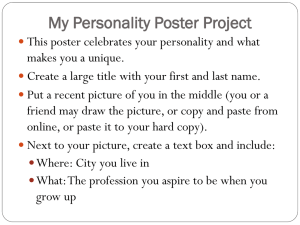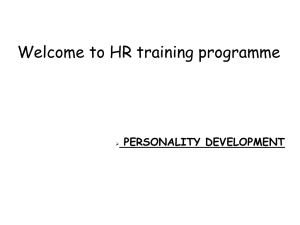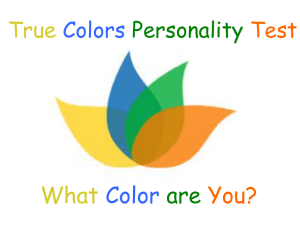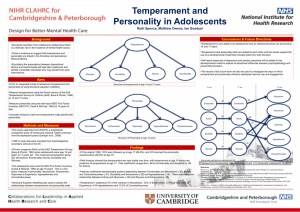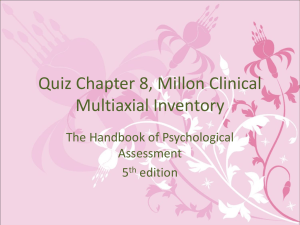pptx
advertisement
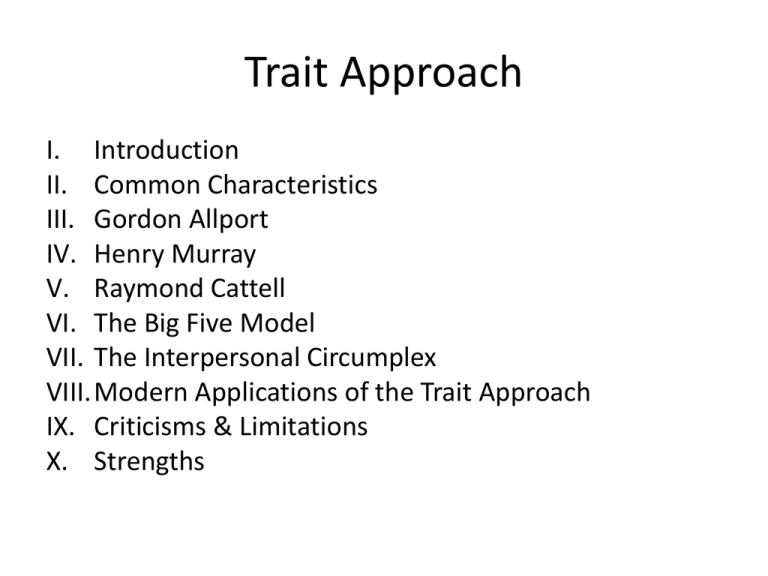
Trait Approach I. Introduction II. Common Characteristics III. Gordon Allport IV. Henry Murray V. Raymond Cattell VI. The Big Five Model VII. The Interpersonal Circumplex VIII.Modern Applications of the Trait Approach IX. Criticisms & Limitations X. Strengths I. Introduction II. Common Characteristics • Focus on average behavior • Less concerned with underlying mechanisms • Less to say about personality change III. Gordon Allport • Nomothetic versus ideographic approaches to personality • Central traits • Secondary traits • Cardinal traits • The proprium IV. Henry Murray • Personology • Psychogenic needs • Some examples: – Achievement – Affiliation – Dominance – Nurturance – Play V. Raymond Cattell • Factor analysis • The 16 Personality Factor Inventory Factor Contrast Warmth Cold, selfish Supportive, comforting Intellect Instinctive, unstable Cerebral, analytical Emotional Stability Irritable, moody Level headed, calm Aggressiveness Modest, docile Controlling, tough Liveliness Somber, restrained Dutifulness Untraditional, rebellious Social Assertiveness Shy, withdrawn Sensitivity Coarse, tough Paranoia Trusting, easy-going Abstractness Practical, regular Introversion Open friendly Anxiety Confident, self-assured Open-mindedness Set-in-one’s-ways Curious, exploratory Independence Outgoing, social Loner, craves solitude Perfectionism Disorganized, messy Tension Relaxed, cool Wild, fun-loving Conforming, traditional Uninhibited, bold Touchy, soft Wary, suspicious Strange, imaginative Private, quiet Fearful, self-doubting Orderly, thorough Stressed, unsatisfied VI. The Big Five Approach Trait Contrast Openness Down to earth Conventional, uncreative Prefer routine Conscientiousness Lazy Aimless Quitting Hardworking Ambitious Persevering Extraversion Reserved Loner Quiet Affectionate Joiner Talkative Agreeableness Antagonistic Ruthless Suspicious Acquiescent Softhearted Trusting Neuroticism (emotional Calm Even tempered Hardy Stability Imaginative Original, creative Prefer variety Worrying Temperamental Vulnerable VII. The Interpersonal Circumplex Sample Scatter Plot Correlation Matrix Trait 1. Forceful 2. Assertive 3. Meek 4. Timid 5. Kind 6. Agreeable 7. Cold 8. Cruel 1 2 3 4 5 6 7 8 1.00 .77 -.81 -.84 .12 .04 -.08 .01 1.00 -.77 -.83 .06 .05 .11 -.09 1.00 .79 .02 -.04 .01 .07 1.00 .12 .06 .08 -.09 1.00 .78 -.81 -.90 1.00 -.78 -.80 1.00 .77 1.00 Interpersonal Dimensions Forceful Assertive Dominant Cold Cruel Hostile Friendly Submissive Meek Timid Kind Agreeable Laws of Complementarity • • • • Dominance pulls submission Submission pulls dominance Friendliness pulls friendliness Hostility pulls hostility Interpersonal Circumplex Types • Hostile-Submissive Types: – Rebellious Distrustful Personality – Self-effacing Masochistic Personality • Friendly-Submissive Types – Docile Dependent Personality – Cooperative Overconventional Personality Interpersonal Circumplex Types • Friendly-Dominant Types: – Responsible Hypernormal Personality – Managerial Autocratic Personality • Hostile-Dominant Types – Competitive Narcissistic Personality – Aggressive Sadistic Personality VIII. Modern Applications of the Trait Approach • Type A Behavior • The MMPI MMPI • Example of an “empirically derived” test • Questions “earn” their way onto the final test by statistically differentiating different groups of people (people with and without depression, people with and without schizophrenia, people with and without alcohol problems, etc…) Simulated MMPI Items Simulated MMPI Items MMPI Clinical Scales MMPI Clinical Scales IX. Criticisms & Limitations X. Strengths The Biological Perspective I. II. III. IV. V. VI. Introduction Genetic Factors in Personality Eysenck’s Theory of Personality Temperament Cerebral Activation Patterns Evolutionary Personality Theory I. Introduction II. Genetic Factors in Personality Trait Genetic (Heritability) Familial Environment Non-shared Environment Well-being .48 .13 .39 Social Potency .54 .10 .39 Achievement .39 .11 .50 Social Closeness .40 .19 .41 Stress Reaction .53 .00 .47 Alienation .45 .11 .54 Aggression .44 .00 .56 Control .44 .00 .56 Harm Avoidance .55 .00 .45 Traditionalism .45 .12 .43 Absorption .50 .03 .47 Positive Emotionality .40 .22 .38 Negative Emotionality .55 .02 .43 Constraint .58 .00 .42 (Tellegen et al., 1988) III. Eysenck’s Theory of Personality Eysenck’s Supertraits or Types • Extraversion • Neuroticism • Psychoticism Eysenck’s Hierarchical Model Extraversion Sociability HR1 HR2 Impulsiveness Activity Liveliness Excitability HR3 SR1 SR2 SR3 SR4 ……………………………………………………………………………………………………………………. Eysenck’s Two-Factor Model Extraversion & Mood 3 2.5 2 Positive Mood Score Introverts 1.5 Extraverts 1 0.5 0 Mon Tue Wed Thur Fri Sat Sun IV. Temperament Buss & Plomin’s Temperament Factors • Activity – Vigor, tempo • Emotionality – Fear, anger, distress • Sociability – Attention of others, share activities, interaction • (Impulsivity) Temperament and Genetics 0.7 0.6 0.5 Degree of Correlation 0.4 0.3 Identical Twins 0.2 Fraternal Twins 0.1 0 -0.1 -0.2 Emotionality Activity Sociability V. Cerebral Activation Patterns VI. Evolutionary Personality Theory What if Charles Darwin had been a psychologist? “So, tell me about your mother…” The Humanistic Approach I. Introduction II. The Personality Theory of Carl Rogers III. Modern Humanistic Concepts I. Introduction Roots of the Humanistic Movement • Existential philosophy • The ideas of Carl Rogers & Abraham Maslow Common Characteristics of Humanistic Theories • • • • An emphasis on personal responsibility Here and now focus Phenomenology Growth II. The Personality Theory of Carl Rogers Rogers’ Fully-Functioning Person • Trust their feelings/Intuitions • Experience feelings intensely & deeply • Accept and express all feelings • Less likely to conform to social roles • Present focused • Honest & open • Open to and learn from experience • Constantly developing & growing • Oriented towards fully living life • Show care and concern for others • Creative Key Definitions • Self-Concept: An organized set of beliefs that you hold about yourself. (Who are you? Describe yourself.) • Self-Esteem: One’s feelings of high or low selfworth (How do you feel about your selfconcept?) Basic Needs • Self-consistency: The absence of major conflict between self-perceptions • Congruence: Consistency between selfperceptions and experience Anxiety & Defense • Subception: the unconscious perception of incongruence • Triggers defenses of distortion & denial Incongruence Self-Concept Experience Congruence & the Fully Functioning Person Self-Concept Experience Conditional & Unconditional Positive Regard • Additional needs: – Positive regard – Positive self-regard • Conditional positive regard from parents creates “conditions of worth” Conditions of Worth • Personal standards that dictate when a person can feel OK about him/herself. Sample Q-Sort Statements • • • • • • • • I am optimistic. I often feel guilty. I am intelligent. I express my emotions freely. I understand myself. I am lazy. I am generally happy. I am moody. • • • • • • • • I am ambitious I am an impulsive person. I get anxious easily. I make strong demands on myself. I get along easily with others. I often feel driven. I am self-reliant. I am responsible for my troubles. The Q-Sort & Psychotherapeutic Change III. Modern Humanistic Concepts Self-Esteem & Failure (Brockner et al., 1987) 90 80 70 60 Grade on Second Test 50 High Self-Esteem 40 Low Self-Esteem 30 20 10 0 Did Well on First Test Did Poorly on First Test Social Attribute Ratings & Self-Esteem (Brown & Smart, 1991) 7 6 5 Rating of Social 4 Attributes 3 Success Failure 2 1 0 High Self-Esteem Low Self-Esteem Do you want to compare your exam to another student’s? Told this student did… Self-esteem High Low worse than you. “Sure!” “Why Not.” better than you. “Let’s do it.” “NO WAY!” Self-Esteem & Western Culture Exposure in Asian-Canadians (APA, 1999) Rosenberg Self-Esteem Scale Score 3rd Generation 2nd Generation Long-Term Immigrants Recent Immigrants Been Abroad Never Been Abroad 0 5 10 15 20 25 30 35 40 45






